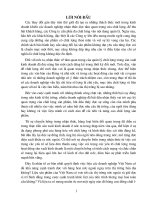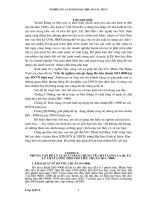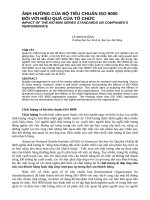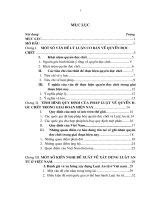Tiêu chuẩn iso 00763 2003
Bạn đang xem bản rút gọn của tài liệu. Xem và tải ngay bản đầy đủ của tài liệu tại đây (146.6 KB, 10 trang )
ISO
763
INTERNATIONAL
STANDARD
Second edition
2003-12-01
Fruit and vegetable products —
Determination of ash insoluble in
hydrochloric acid
--`,,`,-`-`,,`,,`,`,,`---
Produits dérivés des fruits et légumes — Détermination des cendres
insolubles dans l'acide chlorhydrique
Reference number
ISO 763:2003(E)
Copyright International Organization for Standardization
Provided by IHS under license with ISO
No reproduction or networking permitted without license from IHS
© ISO 2003
Not for Resale
ISO 763:2003(E)
--`,,`,-`-`,,`,,`,`,,`---
PDF disclaimer
This PDF file may contain embedded typefaces. In accordance with Adobe's licensing policy, this file may be printed or viewed but
shall not be edited unless the typefaces which are embedded are licensed to and installed on the computer performing the editing. In
downloading this file, parties accept therein the responsibility of not infringing Adobe's licensing policy. The ISO Central Secretariat
accepts no liability in this area.
Adobe is a trademark of Adobe Systems Incorporated.
Details of the software products used to create this PDF file can be found in the General Info relative to the file; the PDF-creation
parameters were optimized for printing. Every care has been taken to ensure that the file is suitable for use by ISO member bodies. In
the unlikely event that a problem relating to it is found, please inform the Central Secretariat at the address given below.
© ISO 2003
All rights reserved. Unless otherwise specified, no part of this publication may be reproduced or utilized in any form or by any means,
electronic or mechanical, including photocopying and microfilm, without permission in writing from either ISO at the address below or
ISO's member body in the country of the requester.
ISO copyright office
Case postale 56 • CH-1211 Geneva 20
Tel. + 41 22 749 01 11
Fax + 41 22 749 09 47
Web www.iso.org
Published in Switzerland
ii
Copyright International Organization for Standardization
Provided by IHS under license with ISO
No reproduction or networking permitted without license from IHS
© ISO 2003 — All rights reserved
Not for Resale
ISO 763:2003(E)
Foreword
ISO (the International Organization for Standardization) is a worldwide federation of national standards bodies
(ISO member bodies). The work of preparing International Standards is normally carried out through ISO
technical committees. Each member body interested in a subject for which a technical committee has been
established has the right to be represented on that committee. International organizations, governmental and
non-governmental, in liaison with ISO, also take part in the work. ISO collaborates closely with the
International Electrotechnical Commission (IEC) on all matters of electrotechnical standardization.
International Standards are drafted in accordance with the rules given in the ISO/IEC Directives, Part 2.
The main task of technical committees is to prepare International Standards. Draft International Standards
adopted by the technical committees are circulated to the member bodies for voting. Publication as an
International Standard requires approval by at least 75 % of the member bodies casting a vote.
Attention is drawn to the possibility that some of the elements of this document may be the subject of patent
rights. ISO shall not be held responsible for identifying any or all such patent rights.
ISO 763 was prepared by Technical Committee ISO/TC 34, Food products, Subcommittee SC 3, Fruit and
vegetable products.
This second edition cancels and replaces the first edition (ISO 763:1982), which has been technically revised.
--`,,`,-`-`,,`,,`,`,,`---
iii
© ISO 2003 — All rights reserved
Copyright International Organization for Standardization
Provided by IHS under license with ISO
No reproduction or networking permitted without license from IHS
Not for Resale
--`,,`,-`-`,,`,,`,`,,`---
Copyright International Organization for Standardization
Provided by IHS under license with ISO
No reproduction or networking permitted without license from IHS
Not for Resale
INTERNATIONAL STANDARD
ISO 763:2003(E)
Fruit and vegetable products — Determination of ash insoluble
in hydrochloric acid
1
Scope
This International Standard specifies a method for the determination of the hydrochloric-acid-insoluble ash
yielded by fruit and vegetable products.
The method serves for the determination of siliceous impurities, together with the silica endogenous to the
plant.
NOTE
A method for the determination of mineral impurities generally originating from the soil is specified in
ISO 7621).
2
Principle
A test portion is incinerated at approximately 525 °C and the mineral matter insoluble in dilute hydrochloric
acid is separated.
3
Reagents
3.1
Hydrochloric acid, 10 % (by mass) solution.
3.2
Silver nitrate, approximately 17 g/l solution.
4
--`,,`,-`-`,,`,,`,`,,`---
Use only reagents of recognized analytical grade, unless otherwise specified, and distilled or demineralized
water or water of equivalent purity.
Apparatus
Usual laboratory apparatus and, in particular, the following.
4.1
Blender.
4.2
Muffle furnace, capable of being maintained at 525 °C ± 25 °C.
4.3
Boiling water bath.
4.4
Drying oven, capable of being maintained at 103 °C ± 2 °C.
4.5
Desiccator, containing an efficient desiccant.
4.6
Incineration dishes, made of quartz or platinum.
1)
ISO 762, Fruit and vegetable products — Determination of mineral impurities content.
1
© ISO 2003 — All rights reserved
Copyright International Organization for Standardization
Provided by IHS under license with ISO
No reproduction or networking permitted without license from IHS
Not for Resale
ISO 763:2003(E)
4.7
Filter paper, ashless.
4.8
Analytical balance, capable of weighing to the nearest 0,000 2 g.
--`,,`,-`-`,,`,,`,`,,`---
5
Sampling
It is important that the laboratory receive a sample which is truly representative and has not been damaged or
changed during transport or storage.
6
Preparation of test sample
Allow frozen or deep-frozen products to thaw in a closed vessel and add the liquid formed during this process
to the product before mixing. Before taking the test portion, thoroughly mix the laboratory sample using, if
necessary, the blender (4.1).
7
Procedure
7.1
Preparation of first dish
Heat an empty dish (4.6) in the furnace (4.2) set at the incineration temperature. Allow it to cool in the
desiccator (4.5) then weigh to the nearest 0,000 2 g. Repeat until a constant mass is achieved.
7.2
Test portion
Weigh, to the nearest 0,01 g, in the previously prepared dish (7.1), 4 g to 25 g of the test sample (Clause 6)
according to the water content of the product. For liquid products, the test portion may be taken by volume
(see 8.2).
7.3
7.3.1
Determination
Drying
Place the dish and its contents in the boiling water bath (4.3) and evaporate the water present in the product.
Dry in the oven (4.4) set at 103 °C. This drying is not necessary for dry products.
7.3.2
Incineration
After drying (if appropriate), carbonize and then completely incinerate the product in the furnace (4.2) set at
525 °C; the ash may still be grey after incineration.
Pre-incineration at a distinctly lower temperature before placing in the furnace is sometimes necessary for
products with a high sugar content in order to avoid foaming and subsequent loss of foam. For that purpose,
slowly heat the dried sample on the hot plate until carbonization of the most of the organic matter.
It is recommended to decrease the salt content of products containing more than 2 % of sodium chloride by
the following method. Pre-incinerate the sample then wash the carbonaceous residue several times with small
amounts of hot distilled water.
7.3.3
Treatment with hydrochloric acid
Allow the sample to cool in the desiccator (4.5). After cooling, add 10 ml to 25 ml of the hydrochloric acid
solution (3.1). Cover with a watch-glass and heat in the boiling water bath (4.3) for 15 min ± 2 min.
2
Copyright International Organization for Standardization
Provided by IHS under license with ISO
No reproduction or networking permitted without license from IHS
© ISO 2003 — All rights reserved
Not for Resale
ISO 763:2003(E)
Transfer the residue to the ashless filter paper (4.7) placed in a funnel. Rinse the dish with hot water and
transfer the contents of the dish to the filter paper. Wash the filter paper and its contents until there is no trace
of chloride ions in the liquid flowing from the funnel [test with the silver nitrate solution (3.2)].
7.3.4
Preparation of the second dish
Prepare a new dish (4.6) as specified in 7.1 or clean the first dish. Heat it in the muffle furnace (4.2) to the
incineration temperature. Allow it to cool in the desiccator then weigh to the nearest 0,000 2 g. Repeat until a
constant mass is achieved.
7.3.5
Drying and incineration
Place the filter paper and residue in the dish. Dry in the oven (4.4) set at 103 °C, then incinerate in the muffle
furnace (4.2), set at 525 °C, for 30 min ± 2 min.
Cool in the desiccator (4.5), then weigh to the nearest 0,000 2 g. Repeat until a constant mass is achieved.
8
8.1
Expression of results
Method of calculation
The ash insoluble in hydrochloric acid, w, expressed as a percentage by mass, is given by the formula
--`,,`,-`-`,,`,,`,`,,`---
w=
m 2 − m3
× 100 %
m 0 − m1
where
m0
is the mass, in grams, of the dish and test portion (7.2);
m1
is the mass, in grams, of the empty dish (7.1);
m2
is the mass, in grams, of the dish and acid-insoluble ash (7.3.5);
m3
is the mass, in grams, of the second empty dish (7.3.4).
Report the results to two decimal places.
8.2
Other method of expression
For liquid products, it is possible to express the result in grams per 100 ml of product, by taking the test
portion (7.2) by volume and by replacing the denominator (m0 − m1) in the equation (see 8.1) by V, the volume
of the test portion.
9
Repeatability
The absolute difference between two independent single test results, obtained using the same method on
identical test material in the same laboratory by the same operator using the same equipment within a short
interval of time, will in not more than 5 % of cases be greater than 0,01 g of ash insoluble in hydrochloric acid
per 100 g of sample.
3
© ISO 2003 — All rights reserved
Copyright International Organization for Standardization
Provided by IHS under license with ISO
No reproduction or networking permitted without license from IHS
Not for Resale
ISO 763:2003(E)
10 Test report
The test report shall specify:
all information necessary for the complete identification of the sample;
b)
the sampling method used, if known;
c)
the test method used, with reference to this International Standard;
d)
all operating details not specified in this International Standard, or regarded as optional, together with
details of any incidents which may have influenced the test result(s);
e)
the test result(s) obtained or, if the repeatability has been checked, the final quoted result obtained.
--`,,`,-`-`,,`,,`,`,,`---
a)
4
Copyright International Organization for Standardization
Provided by IHS under license with ISO
No reproduction or networking permitted without license from IHS
© ISO 2003 — All rights reserved
Not for Resale
--`,,`,-`-`,,`,,`,`,,`---
Copyright International Organization for Standardization
Provided by IHS under license with ISO
No reproduction or networking permitted without license from IHS
Not for Resale
ISO 763:2003(E)
--`,,`,-`-`,,`,,`,`,,`---
ICS 67.080.01
Price based on 4 pages
© ISO 2003 — All rights reserved
Copyright International Organization for Standardization
Provided by IHS under license with ISO
No reproduction or networking permitted without license from IHS
Not for Resale









